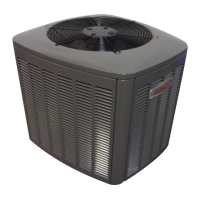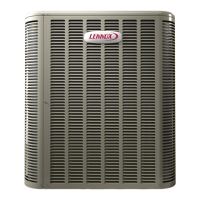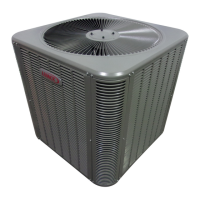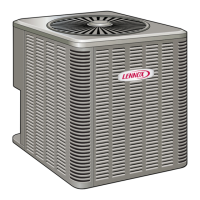Page 15
13ACD SERIES
1. Determine the desired DTMeasure entering air temperature
using dry bulb (A) and wet bulb (B). DT is the intersecting value of A
and B in the table (see triangle).
2. Find temperature drop across coilMeasure the coil’s dry bulb
entering and leaving air temperatures (A and C). Temperature Drop
Formula: (T
Drop
) = A minus C.
3. Determine if fan needs adjustmentIf the difference between the
measured T
Drop
and the desired DT (T
Drop
–DT) is within +3º, no ad-
justment is needed. See examples: Assume DT = 15 and A temp. =
72º, these C temperatures would necessitate stated actions:
Cº T
Drop
– DT = ºF ACTION
53º 19 – 15 = 4 Increase the airflow
58º 14 – 15 = −1 (within +3º range) no change
62º 10 – 15 = −5 Decrease the airflow
4. Adjust the fan speedSee indoor unit instructions to increase/de-
crease fan speed.
Changing air flow affects all temperatures; recheck temperatures to
confirm that the temperature drop and DT are within +3º.
Delta−T
80 24 24 24 23 23 22 22 22 20 19 18 17 16 15
78 23 23 23 22 22 21 21 20 19 18 17 16 15 14
76 22 22 22 21 21 20 19 19 18 17 16 15 14 13
74 21 21 21 20 19 19 18 17 16 16 15 14 13 12
72 20 20 19 18 17 17 16 15 15 14 13 12 11 10
70 19 19 18 18 17 17 16 15 15 14 13 12 11 10
57 58 59 60 61 62 63 64 65 66 67 68 69 70
Temp.
of air
entering
indoor
coil ºF
INDOOR
COIL
DRY
BULB
DRY
BULB
WET
BULB
B
T
Drop
19º
A
Dry−bulb
Wet−bulb ºF
A
72º
B
64º
C
53º
air flowair flow
All temperatures are
expressed in ºF
Figure 27. Checking Indoor Airflow over Evaporator Coil using Delta−T Chart
WHEN TO CHARGE?
Warm weather best
Can charge in colder weather
CHARGE METHOD? Determine by:
Metering device type
Outdoor ambient temperature
REQUIREMENTS:
Sufficient heat load in structure
Indoor temperature between 70-80ºF (21−26ºC)
Manifold gauge set connected to unit
Thermometers:
− to measure outdoor ambient temperature
− to measure liquid line temperature
− to measure suction line temperature
TXV RFC
APPROACH OR
SUBCOOLING
WEIGH-IN SUPERHEAT
Which
metering
device?
Below 65ºF
(18ºC)?
Above 40ºF
(4ºC)?
Above 65ºF
(18ºC)?
START: Determine how refrigerant is metered
Figure 28. Determining Charge Method
START: Measure outdoor ambient temperature
BELOW
1. Check Liquid and suction line pressures
2. Compare unit pressures with Table 6,
Normal Operating Pressures.
3. Conduct leak check; evacuate as
previously outlined.
4. Weigh in the unit nameplate charge plus
any charge required for line set differences
over feet.
Liquid Line
Set Diameter
Ounces per 5 feet (g per 1.5 m)
adjust from 15 feet (4.6 m) line set*
3/8" (9.5 mm)
3 ounce per 5’ (85 g per 1.5 m)
NOTE − *If line length is greater than 15 ft. (4.6 m), add this
amount. If line length is less than 15 ft. (4.6 m), subtract this
amount.
Refrigerant Charge per Line Set Length
ABOVE
USE EITHER APPROACH
OR SUBCOOLING
METHOD
This nameplate is for illustration purposes
only. Go to actual nameplate on outdoor
unit for charge information.
Above or
below 65ºF
(18ºC)?
WEIGH IN TXV/RFC
Figure 29. HCFC−22 Weigh In TXV Method

